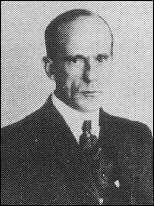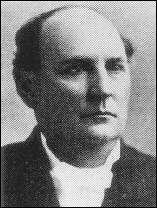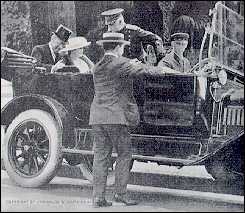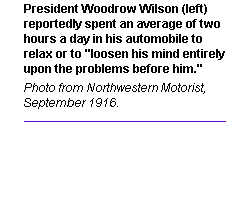BUILDING THE FOUNDATION
by Richard F. Weingroff
Sidebars
A Progressive Leader
LOGAN WALLER PAGE
 Born
on Jan. 10, 1870, in Richmond, Va., Logan Waller Page was a member of a family that
distinguished itself in Virginia history for several centuries. He was educated at
the Virginia Polytechnic Institute and the Lawrence Scientific School of Harvard University.
He became geologist and testing engineer for the Massachusetts Highway Commission
in 1893, and he joined the U.S. Office of Public Road Inquiries (OPRI) as chief of
tests in 1900. In 1905, the OPRI was renamed the Office of Public Roads (OPR), and
Page was selected to be the director of OPR, which was given an expanded mission and
increased funding.
Born
on Jan. 10, 1870, in Richmond, Va., Logan Waller Page was a member of a family that
distinguished itself in Virginia history for several centuries. He was educated at
the Virginia Polytechnic Institute and the Lawrence Scientific School of Harvard University.
He became geologist and testing engineer for the Massachusetts Highway Commission
in 1893, and he joined the U.S. Office of Public Road Inquiries (OPRI) as chief of
tests in 1900. In 1905, the OPRI was renamed the Office of Public Roads (OPR), and
Page was selected to be the director of OPR, which was given an expanded mission and
increased funding. Page and the agency he shaped embodied the Progressive Era belief that
fact- and data-based technicians would solve society's problems. He applied a scientific
approach to road problems. Page was also a tireless good roads promoter, who encouraged
the states to create highway programs, staffed with engineers. In many cases, he helped
draft the enabling legislation. Page was one of the founders of the American Association
of State Highway Officials (AASHO), and he worked closely with AASHO to secure passage
of the Federal Aid Road Act of 1916 and to get the new federal-aid highway program
under way.
On Dec. 9, 1918, Page died while in Chicago for a meeting of AASHO's Executive
Committee. He was survived by his widow and his 9-year-old son, Lee. An AASHO tribute
said that Page "contributed much to smooth the ways of travel, to turn aside
the stones over which we stumble, to widen the avenues along which we must work, and
has made safer, brighter and lighter the Nation's pathways for the feet of commerce,
liberty, and happiness."
Father
of Good Roads in the U.S. Senate
SEN. JOHN HOLLIS BANKHEAD
 A
native of Moscow (now Sulligent), Ala., who was born on Sept. 13, 1842, John Hollis
Bankhead served as a captain of the 16th Alabama Volunteers during the Civil War.
He was wounded three times. Although his primary occupation was planter, he devoted
most of the remainder of his life to public service, first at the state level and
later the national level. First elected to the U.S. House of Representatives in 1887,
he lost his bid for reelection in 1906. In 1907, he was appointed to succeed a senator
who had died in office. Never an ostentatious man, he rode to the Capitol every day
in a streetcar.
A
native of Moscow (now Sulligent), Ala., who was born on Sept. 13, 1842, John Hollis
Bankhead served as a captain of the 16th Alabama Volunteers during the Civil War.
He was wounded three times. Although his primary occupation was planter, he devoted
most of the remainder of his life to public service, first at the state level and
later the national level. First elected to the U.S. House of Representatives in 1887,
he lost his bid for reelection in 1906. In 1907, he was appointed to succeed a senator
who had died in office. Never an ostentatious man, he rode to the Capitol every day
in a streetcar.The Good Roads Movement was one of his favorite causes. In 1912, he told
a good roads convention, "God being my helper and preserving my life, I intend,
sir, to devote that time in urging upon Congress and the country the adoption of a
system of national and state aid in cooperation." He redeemed that pledge in
1916 when he sponsored the Federal Aid Road Act, which had been developed by his friend
Logan Page and the American Association of State Highway Officials. During his lifetime,
the legislation was often called "the Bankhead bill."
To honor the man who was known as "The Father of Good Roads in the
United States Senate," a southern transcontinental highway from Washington, D.C.,
to the Pacific Coast was named the Bankhead Highway. Remnants of the route are still
known as the Bankhead Highway in some parts of the country.
When Bankhead died on March 1, 1920, he was, at 77, the oldest man in
the Senate, and the Senate's last survivor of the Civil War. He was survived by his
wife, Tallulah, and two sons, Sen. John Bankhead Jr. and Rep. William B. Bankhead.
They went on to distinguished congressional careers; Rep. Bankhead served as speaker
of the House from 1936 until his death in 1940. The actress Tallulah Bankhead was
the speaker's daughter.
PRESIDENT
WOODROW WILSON --Motorist Extraordinaire


"My interest in good roads is not merely an interest
in the pleasure of riding in automobiles, it is not merely an interest in the very
much more important matter of affording the farmers of this country and the residents
in villages the means of ready access to such neighboring markets as they need for
the economic benefit, but it is also the interest in weaving as complicated and elaborate
a net of neighborhood and state and national opinions together as it is possible to
weave. It is of the most fundamental importance that the United State should think
in big pieces, should think together, should think ultimately as a whole. ...I believe
that it is the proper study of the statesman to bind communities together and open
their intercourse so that it will flow with absolute freedom and facility."
Motoring was one of President Wilson's favorite activities during his
years in the White House (1913-1921) and in the remaining years of his life. (He died
Feb. 3, 1924.) Soon after arriving in the White House, he began his motoring adventures.
He mapped out a series of routes - known as the Number One Ride, the Southern Maryland
Ride, and the Potomac Ride - that he and the first lady enjoyed.
Following the death of his first wife in 1915, the president was encouraged
by his doctor to keep up his golfing and auto rides. Soon, Wilson met and fell in
love with Edith Bolling Galt, a widowed Washington businesswoman. He courted her partly
during their long drives in the White House Pierce-Arrow automobile. On one such ride,
on Sept. 3, 1915, through Rock Creek Park, she accepted his proposal to become his
second wife.
The following is extracted from an article, "President Wilson the
Motorist," by L. Ames Brown. The article was published in the September 1916
edition of Northwestern Motorist.
"No more ardent motorist ever occupied the White House than President
Wilson. ...Mr. Wilson probably has spent an average of two hours a day in an automobile
since he became president.
"He prefers to ride with the top down. ...His choice of a seat depends
upon the purpose of the ride. If he intends to do some thinking, he is almost certain
to sit beside the chauffeur. If he is out solely to relax, he joins his companions
in the [back seat] and mingles in their conversation. An automobile load of Secret
Service men always accompanies the president's car, whether the journey be some 150
miles through the Green Mountains or merely from the White House to one of the Washington
theatres.
"Motoring is the president's chief form of recreation during his
vacations.
"Like every other experienced motor enthusiast, Mr. Wilson is an
ardent advocate of good roads. A splendid earnest of his attitude and of the lessons
he had learned from experience in the White House automobile was given July 11, 1916,
when Mr. Wilson affixed his signature to the [Federal Aid Road Act of 1916]. The president
had been a vigorous advocate of this measure, and he signed it with genuine enthusiasm.
"The president's views on good roads development were epitomized
in this plank of the Democratic platform adopted at St. Louis in June [1916], when
he personally drew: 'The happiness, comfort and prosperity of rural life, and the
development of the city, are alike conserved by the construction of public highways.
We, therefore, favor national aid in the construction of post roads and roads for
military purposes."
Go to the Public
Roads Website

 Born
on Jan. 10, 1870, in Richmond, Va., Logan Waller Page was a member of a family that
distinguished itself in Virginia history for several centuries. He was educated at
the Virginia Polytechnic Institute and the Lawrence Scientific School of Harvard University.
He became geologist and testing engineer for the Massachusetts Highway Commission
in 1893, and he joined the U.S. Office of Public Road Inquiries (OPRI) as chief of
tests in 1900. In 1905, the OPRI was renamed the Office of Public Roads (OPR), and
Page was selected to be the director of OPR, which was given an expanded mission and
increased funding.
Born
on Jan. 10, 1870, in Richmond, Va., Logan Waller Page was a member of a family that
distinguished itself in Virginia history for several centuries. He was educated at
the Virginia Polytechnic Institute and the Lawrence Scientific School of Harvard University.
He became geologist and testing engineer for the Massachusetts Highway Commission
in 1893, and he joined the U.S. Office of Public Road Inquiries (OPRI) as chief of
tests in 1900. In 1905, the OPRI was renamed the Office of Public Roads (OPR), and
Page was selected to be the director of OPR, which was given an expanded mission and
increased funding. 
 A
native of Moscow (now Sulligent), Ala., who was born on Sept. 13, 1842, John Hollis
Bankhead served as a captain of the 16th Alabama Volunteers during the Civil War.
He was wounded three times. Although his primary occupation was planter, he devoted
most of the remainder of his life to public service, first at the state level and
later the national level. First elected to the U.S. House of Representatives in 1887,
he lost his bid for reelection in 1906. In 1907, he was appointed to succeed a senator
who had died in office. Never an ostentatious man, he rode to the Capitol every day
in a streetcar.
A
native of Moscow (now Sulligent), Ala., who was born on Sept. 13, 1842, John Hollis
Bankhead served as a captain of the 16th Alabama Volunteers during the Civil War.
He was wounded three times. Although his primary occupation was planter, he devoted
most of the remainder of his life to public service, first at the state level and
later the national level. First elected to the U.S. House of Representatives in 1887,
he lost his bid for reelection in 1906. In 1907, he was appointed to succeed a senator
who had died in office. Never an ostentatious man, he rode to the Capitol every day
in a streetcar.
